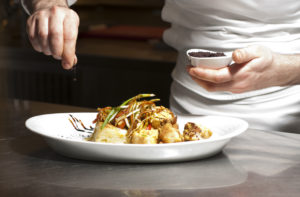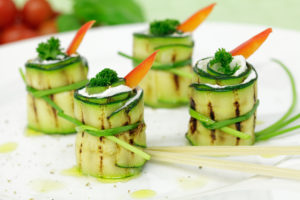During your time in culinary arts programs, you will learn how to cook a wide variety of delicious meals. You will also discover methods for presenting your dishes so they are appealing to the eye, as well as to the taste and smell. Many chefs realize that learning design principles and applying them in the kitchen is increasingly important in today’s 
Why presentation matters
Research has suggested that the experience around eating a piece of food can have a significant effect on how people feel about what they are eating. This includes how an item is set on a plate and presented to diners.
A 2014 study published in the journal Flavour examined how people’s responses to salads made with the same ingredients differed based on appearance. One version came tossed, another neatly arranged and a third elaborately assembled to look like a painting by artist Wassily Kadinsky. Both before and after eating, diners felt more positively about the artistic version, including its taste, and were willing to pay a higher price for it. Psychologist Charles Spence, the study’s co-author, commented on the results to the Guardian.
“A number of chefs now are realizing that they are being judged by how their foods photograph be it in the fancy cookbooks [or], more often than not, when diners Instagram their friends,” he said.
The plating basics
Bringing some design sense to a dish can make the difference between an enjoyable meal and an unforgettable experience that customers will recount to friends. The positioning of the entree, garnishes, sauces, sides and even empty space should all be deliberate.
Keep in mind that how you spatially orient pieces of food in relation to each other determines the path a viewer’s eye travels. Chef’s Blade explained that creating clean lines and shapes will bring a pleasing flow to the presentation. These lines should lead to a focal point that commands the diner’s interest, whether it’s a large piece of the entree or a distinctive garnish.
Your choices of color can also direct the diner’s attention and highlight key ingredients. Select garnishes that will provide pleasant visual contrasts while also adding complementary flavors. The Kitchenthusiast gave the example of adding green beans or kale to an otherwise dull-looking plate of chicken and potatoes.

“Simplicity is always beautiful,” he said. “One thing to keep in mind, though, is that your primary focus should be the quality of your ingredients and execution of your technique used in cooking.”
Presentation pros
Many chefs have built their reputations by employing thoughtful plating to display their superb dishes. By observing how they have incorporated eye-catching designs into quality dining, you may find ideas for assembling unique items of your own.
The chicken liver crostone is a signature item at Zach Pollack’s Alimento in Los Angeles. One side of the plate is covered by a rich liver mousse flavored with Marsala wine. On the opposite end, the chef sets the toasted bread, ready to be topped and devoured. Bon Appetit pointed out that this asymmetrical appearance contributes a sense of drama while also giving the patron direction for how to dig in.
At Estela in New York City, chef Ignacio Mattos aims for an unassuming, plain look that values excellent ingredients and an element of surprise over immediate flashiness. Nonetheless, the presentation is a memorable part of the dining experience. Serious Eats described a plate of freshly fried potato chips that conceals a pork shoulder steak. Marinated with dijon, rosemary, garlic and fennel seeds, the steak is then pan roasted and served with a yogurt sauce.
Chefs put countless hours into learning how to combine complementary flavors and cook each item to perfection. Still, how they display the results matters as well. By finding your own visual approach to plating, you could lure in loyal diners who appreciate your attention to detail.


